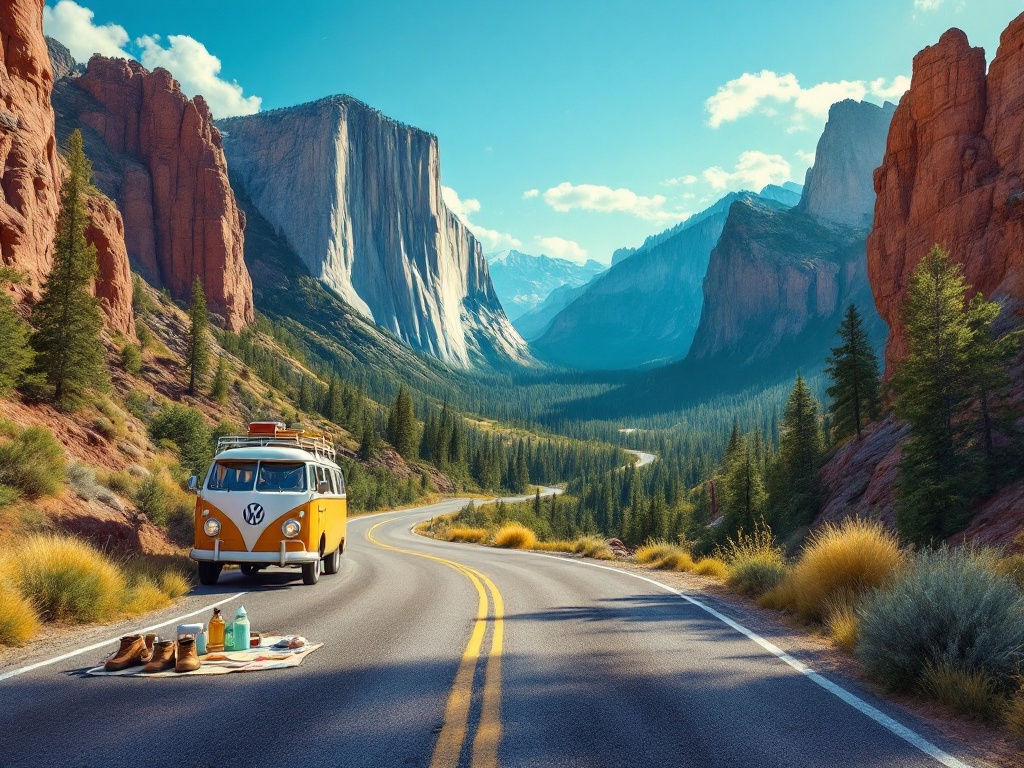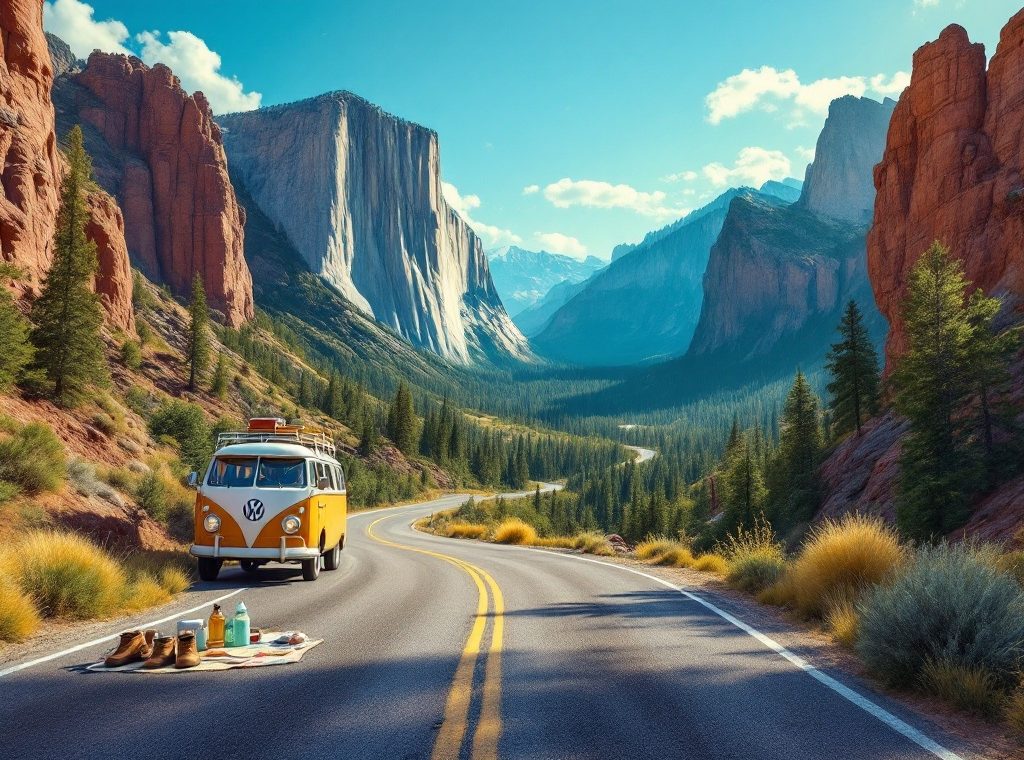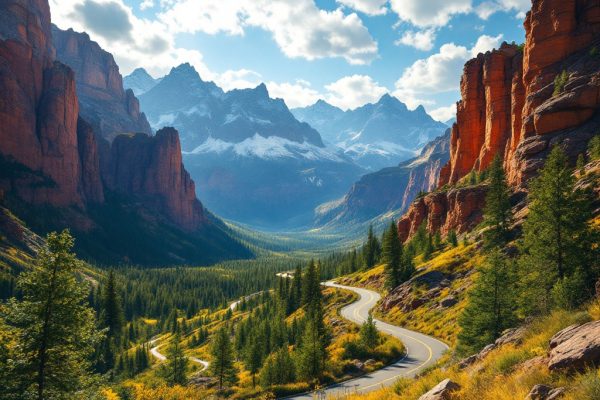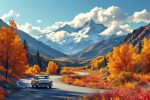Exploring America’s Wonders: A National Park Road Trip Guide
Dreaming of a breathtaking road trip through America’s majestic National Parks? Discover how to plan an unforgettable adventure! From choosing the perfect parks and mapping your route to securing accommodations and packing essential gear, our guide covers everything. Learn about the America the Beautiful Pass, saving you money while exploring over 2,000 stunning locations. Start planning your dream National Park road trip today!
Important information

- Plan your trip by researching parks, mapping your route, and booking accommodations in advance.
- Purchase an “America the Beautiful Pass” for cost-effective access to over 2,000 parks and sites.
- Pack layers, sturdy boots, water bottles, and safety gear for varied conditions.
- Check park websites for reservations, permits, and specific activity information.
- Respect wildlife by keeping a safe distance and never feeding them. Store food securely.
Planning Your National Park Road Trip
Plan your American National Parks road trip with these essential steps:
Choose your parks. Select the National Parks that ignite your wanderlust, keeping your available time and personal interests in mind.
Research and personalize. Delve into each park’s unique offerings, from hiking trails and scenic overlooks to ranger programs and historical sites, tailoring your itinerary to your preferences.
Map your route. Plan your driving route, factoring in distances and travel times between parks, optimizing your journey for efficiency and enjoyment.
Check fees and permits. Research park entry fees and any necessary reservations or permits to ensure a smooth and hassle-free experience.
Book accommodations. Secure your lodging in advance, especially if traveling during peak season, guaranteeing a comfortable place to rest after your daily adventures.
Pack smart. Pack layers of clothing, durable hiking boots, reusable water bottles, and essential safety gear to prepare for varied weather conditions and outdoor activities.
Consider a National Parks Pass. A National Parks Pass offers convenient and cost-effective access to all parks, enhancing your road trip experience.
Embrace flexibility. Be open to unplanned adventures and captivating detours, allowing for spontaneity and unexpected discoveries along the way.
Route Planning and Scenic Detours
Embark on a road trip through the American Southwest, a region renowned for its scenic national parks and diverse landscapes. Discover breathtaking viewpoints and hidden gems by venturing off the main routes. Many parks offer stunning vistas and peaceful solitude.
For a safe and enjoyable journey, remember to check road conditions before you go and pack plenty of water. This will ensure you’re prepared for the unique challenges of exploring this beautiful region. Enjoy your adventure!
Seasonal Considerations for Your Journey
Shoulder Seasons (Spring and Fall)
experience pleasant weather and fewer crowds during the shoulder seasons of spring (April-May) and fall (September-October). these times offer milder temperatures, ideal for a relaxed visit and comfortable exploration.
Summer Season
summer (June-August) provides ideal conditions for swimming and sunbathing. however, be prepared for larger crowds and potential queues at popular attractions during this peak season.
Travel Essentials: Packing List and Tips
Essentials for your day trip:
- Clothing suitable for all weather conditions.
- Sturdy hiking boots for the trails.
- A reusable water bottle to stay hydrated.
- A first-aid kit for minor emergencies.
- Navigation tools such as map or a GPS device.
- Plenty of snacks.
If you are staying overnight, remember to bring:
- Camping gear, including a tent and a sleeping bag.
- Cooking supplies for meal preparation.
- A camera to capture the scenery.
- Sunscreen and insect repellent.
Understanding Park Entry Reservations and Permits
Plan your visit ahead of time, especially during peak seasons, by checking the park’s website for potential reservation requirements. This system helps manage visitor numbers and preserve the park’s natural beauty. For specific activities like backcountry camping and some hikes, permits are necessary, especially for overnight trips. Some trails may have restricted access. Visit the park’s website for complete information on entry requirements and permits to ensure a smooth and enjoyable park experience.
Using the America the Beautiful Pass
Explore America’s national parks and other federal recreation sites with the America the Beautiful Pass. This $80 pass grants access to over 2,000 breathtaking locations for a full year from the purchase date. Covering entrance, standard amenity, and day-use fees for a driver and all passengers in a personal vehicle, it offers incredible value. Purchase yours today!
Exploring America’s Natural Wonders
America’s national parks offer unique landscapes and experiences. Yellowstone’s geothermal features, including geysers and hot springs, are a must-see. Yosemite captivates with granite cliffs and waterfalls.
- Hiking,
- camping,
- wildlife encounters.
At the Grand Canyon, marvel at its immensity. Zion National Park showcases distinctive canyons and rock formations. Many parks offer ranger-led programs and scenic drives. Check individual park websites for specific activities and permit requirements.
Must-See Attractions in Top National Parks
Grand Canyon National Park is home to the mile-deep Grand Canyon, a breathtaking gorge carved by the Colorado River. Zion National Park features The Narrows, a unique slot canyon hike following the Virgin River, offering an unforgettable experience. Arches National Park presents a different landscape entirely, boasting over 2,000 natural sandstone arches, including the iconic Delicate Arch. Across these parks, hikers of all levels can find incredible trails and diverse scenery.
Scenic Routes: Discovering Hidden Gems
Discover hidden gems within national parks by exploring scenic routes. These roads offer unique perspectives and access to secluded areas, such as hidden waterfalls and panoramic viewpoints. You may even encounter diverse wildlife. Finding these treasures requires some research. Consult travel blogs and local tourism websites for valuable insights. Park rangers can also offer invaluable recommendations. Venturing onto these less-traveled paths often leads to breathtaking landscapes and unforgettable experiences.
Geothermal Activity and Unique Landscapes
Yellowstone National Park is a geothermal wonderland, home to geysers and hot springs. National parks often encompass diverse ecosystems, ranging from lush forests and arid deserts to deep canyons. The Grand Canyon, carved by the Colorado River, presents a breathtaking spectacle of unique landscapes. Yosemite National Park, with its granite cliffs and cascading waterfalls, is equally awe-inspiring. Here are some of the most popular US National Parks:
- Yellowstone: known for its geysers, hot springs, and diverse wildlife, including bison and elk.
- Grand Canyon: famous for its immense size, stunning rock formations, and the powerful Colorado River.
- Yosemite: renowned for its towering granite cliffs, giant sequoia trees, and iconic waterfalls like Yosemite Falls.
Photographic Wonders: Horseshoe Bend and Beyond
Horseshoe Bend, a dramatic curve in the Colorado River near Page, Arizona, is a photographer’s paradise. Its unique horseshoe shape and vibrant landscape create stunning images. Nearby, Antelope Canyon boasts colorful rock formations. Zion and Bryce Canyon National Parks offer breathtaking vistas just a short drive away. These parks provide endless inspiration for photographers of all skill levels.
Highlighting Iconic National Parks
Grand Canyon National Park offers two distinct experiences:
- the easily accessible South Rim with its numerous viewpoints,
- the remote North Rim, a haven for those seeking solitude.
Zion National Park in Utah invites adventurers to hike The Narrows, a unique slot canyon carved by the Virgin River.
Utah also boasts two other spectacular parks:
- Arches National Park: home to over 2,000 breathtaking natural sandstone arches,
- Canyonlands National Park: where the Colorado and Green Rivers have sculpted dramatic canyons and mesas.
Grand Canyon National Park: South Rim and North Rim
South Rim
Open year-round, the South Rim offers convenient access to paved trails and numerous viewpoints. It’s ideal for visitors looking for an easily accessible and less strenuous experience.
- Open year-round,
- Paved trails,
- Numerous viewpoints.
North Rim
Open from mid-May to mid-October, the North Rim offers a quieter and less crowded experience. Its higher elevation and more challenging trails attract hikers seeking a unique perspective of the canyon’s grandeur.
- Open mid-May to mid-October,
- Quieter and less crowded,
- More challenging trails.
Zion National Park: The World-Famous Narrows
Zion National Park is famous for The Narrows, a unique slot canyon offering breathtaking views and memorable hikes. It’s a must-see.
Arches National Park: Over 2,000 Natural Stone Arches
Utah’s Arches National Park is renowned for its stunning sandstone formations, including over 2,000 natural arches. Among the most awe-inspiring are Landscape Arch and Delicate Arch, sculpted over millions of years by wind and water. Beyond these iconic arches, the park also features towering pinnacles and precariously balanced rocks, all set against a dramatic desert backdrop.
Canyonlands National Park: An Overlooked Gem
Canyonlands National Park, while less traveled than famous locations like Yellowstone or the Grand Canyon, presents a truly special adventure. The park’s breathtaking views and stunning landscapes of canyons, mesas, and buttes, carved by the Colorado and Green Rivers, create a dramatic, otherworldly experience.
National Park Adventures for Everyone
Explore the breathtaking beauty of America’s national parks. Whether you prefer a relaxing stroll or an invigorating hike, there’s a trail to suit every fitness level. Families can enjoy leisurely walks amidst stunning scenery, while experienced hikers can challenge themselves on more demanding routes.
Camping Adventures
Pitch your tent or park your RV in designated camping areas within the parks. Enjoy the tranquility of nature and the camaraderie of fellow campers.
Water Activities
Dive into the refreshing waters of lakes and rivers. Go rafting, kayaking, or simply enjoy a leisurely swim. Many parks offer boat rentals and guided water tours.
Educational Programs
Join ranger-led programs and guided tours to learn about the fascinating natural and cultural history of the parks. Discover the unique flora, fauna, and geological formations.
Accessibility
Many national parks offer accessible trails and facilities, ensuring that everyone can experience the wonders of nature. Check individual park websites for specific accessibility information.
Plan your visit today and create unforgettable memories in America’s national parks.
Hiking Trails: From Easy Strolls to Challenging Treks
National parks offer trails for every level of hiker, from easy paths perfect for beginners to challenging treks that will test even the most seasoned adventurers. There’s something for everyone.
Camping and RVing: Finding the Best Spots
Planning a camping trip to a national park? Many campgrounds offer amenities such as restrooms, picnic tables, and fire pits for a comfortable stay. Reserving your campsite in advance is highly recommended, especially during peak season. Familiarize yourself with the park’s specific regulations, including campfire guidelines. RV campers should confirm campground size limits and hookup availability. Carefully plan your route, researching RV-friendly roads and parking within the park. Many campgrounds offer convenient dump stations and water refills for RVs.
For all Campers
- Reserve your campsite in advance, especially during peak season.
- Familiarize yourself with the park’s specific regulations, including campfire guidelines.
For RV Campers
- Confirm campground size limits and hookup availability.
- Research RV-friendly roads and parking options within the park.
- Locate dump stations and water refills within the campground.
Water Activities: Rafting, Kayaking, and Swimming
National parks offer diverse water activities, from tranquil lakes ideal for swimming to the thrill of whitewater rafting. Kayaking is another popular option. However, prioritize safety and consult park regulations before participating in any water activities. Some parks may require permits for certain activities or offer guided tours for a more structured experience. Be aware of additional rules that may apply to specific water activities. With a little planning, you can safely enjoy the aquatic adventures these parks offer.
Ranger Programs and Guided Tours
Park rangers enhance your park experience by offering guided tours that explore the park’s ecology, history, and geology. Many parks also feature ranger-led hikes, talks, and photography workshops. These programs cater to visitors of all ages and interests. Check the park’s website for program details and schedules.
Family-Friendly National Park Experiences
Explore safe and exciting hikes in national parks perfect for children. Many parks feature easy trails and paved paths suitable for little legs. For example, consider Zion’s paved Riverside Walk or the Grand Canyon’s Trail of Time.
Educational Opportunities
National parks offer engaging educational opportunities for kids. Junior Ranger programs immerse children in park activities, while interactive exhibits at visitor centers enhance learning.
Respecting Wildlife
Wildlife viewing is a thrilling experience, but respect is crucial. Observe animals from a safe distance, using binoculars for close-up views without disturbing them. Teach children to respect wildlife and their habitats by never feeding or approaching wild animals.
Grand Canyon
Exhibits focus on geology and wildlife.
Arches National Park
Showcases fascinating displays about its unique rock formations.
Safe and Fun Kid-Friendly Hikes
For a leisurely stroll, Big Bend National Park’s paved Lower Creek Trail accommodates strollers and wheelchairs.
Zion National Park’s Pa’rus Trail, also paved, meanders along the Virgin River, showcasing breathtaking canyon vistas.
For a closer look at nature’s wonders, Great Smoky Mountains National Park boasts remarkable, easygoing nature trails teeming with diverse flora and fauna.
Educational Programs and Interactive Exhibits
Explore the diverse ranger programs offered in our national parks.
- Embark on guided walks led by experienced rangers.
- Attend informative talks to deepen your knowledge of the park’s natural and cultural history.
- Gather around a campfire for engaging discussions.
- Explore interactive exhibits at visitor centers, covering the park’s geology, ecology, and history.
- Enroll children in Junior Ranger programs for fun activities and educational booklets.
- Participate in specialized workshops focusing on topics such as photography and astronomy.
These programs cater to various interests, fostering a deeper appreciation for nature and conservation.
Wildlife Watching Etiquette and Tips
Respect wildlife by maintaining a safe distance and never feeding them. Securely store your food to prevent attracting animals to your campsite. If an animal approaches aggressively, slowly back away without making eye contact and report any unusual behavior to a park ranger. Observe your surroundings carefully and avoid disturbing natural habitats. Use binoculars or a spotting scope for close-up views, respecting the animals’ space. Minimize noise and disturbances.
Maintain a Safe Distance: Keep a respectful distance from wildlife and never attempt to feed them. This protects both you and the animals.
Secure Your Food: Store your food and scented items securely to avoid attracting animals to your campsite. This helps prevent unwanted encounters.
Aggressive Encounters: If approached aggressively by an animal, slowly back away without making eye contact. Report any unusual animal behavior to a park ranger immediately.
Respect Habitats: Observe your surroundings carefully and avoid disturbing natural habitats. Use binoculars or a spotting scope for close-up views, respecting the animals’ space.
Minimize Disturbances: Keep noise levels to a minimum to avoid disturbing wildlife and maintain a peaceful park environment.
Learn About Wildlife: Learn about the park’s wildlife and their habits before your visit to ensure a safe and enjoyable experience. Understanding animal behaviors, such as those of bears, can help prevent dangerous encounters and preserve the park’s natural beauty. Remember, wild animals are unpredictable.













